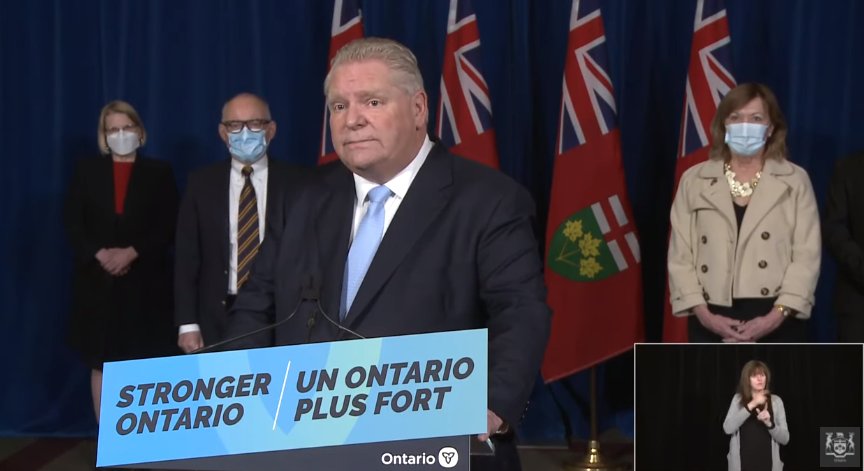
Ontario is speeding up its timeline for easing COVID restrictions.
Premier Doug Ford held a news conference this morning, flanked by Health Minister Christine Elliott and the province’s Chief Medical Officer, Dr. Kieran Moore, to announce starting on Thursday, capacity limits on places that require proof of vaccination will be lifted and social gathering limits will be increased.
“Like all of you, I’ve waited a long time for this news, but please never doubt that the steps we took together, as difficult as they were, were absolutely necessary and saved tens of thousands of lives from COVID-19.”
March 1st, all capacity limits at indoor settings will be eliminated, along with proof of vaccination requirements.
One thing that will not change will be vaccine mandates for places like long term care.
“We want to make sure we secure areas for our most vulnerable, and our most vulnerable are in long term care, they’re in seniors’ homes, and they’re in hospitals as well,” Ford explained. “Since we’ve done that, the numbers have come down, we’re ramping up surgeries again, we’re stabilizing hospitals, the percent positivity has gone from 40 down to 13%, because of the hard work that everyone’s done, we’re seeing movement in a positive way.”
Ford says the easing of restrictions is not because of protests in Ottawa and Windsor, but rather in spite of them.
Effective February 17, 2022
Ontario will further ease public health measures, including, but not limited to:
- Increasing social gathering limits to 50 people indoors and 100 people outdoors
- Increasing organized public event limits to 50 people indoors, with no limit outdoors
- Removing capacity limits in the following indoor public settings where proof of vaccination is required, including but not limited to:
- Restaurants, bars and other food or drink establishments without dance facilities
- Non-spectator areas of sports and recreational fitness facilities, including gyms
- Cinemas
- Meeting and event spaces, including conference centres or convention centres
- Casinos, bingo halls and other gaming establishments
- Indoor areas of settings that choose to opt-in to proof of vaccination requirements.
- Allowing 50 per cent of the usual seating capacity at sports arenas
- Allowing 50 percent of the usual seating capacity for concert venues and theatres
- Increasing indoor capacity limits to 25 per cent in the remaining higher-risk settings where proof of vaccination is required, including nightclubs, restaurants where there is dancing, as well as bathhouses and sex clubs
- Increasing capacity limits for indoor weddings, funerals or religious services, rites, or ceremonies to the number of people who can maintain two metres physical distance. Capacity limits are removed if the location opts-in to use proof of vaccination or if the service, rite, or ceremony is occurring outdoors.
Capacity limits in other indoor public settings, such as grocery stores, pharmacies, retail and shopping malls, will be maintained at, or increased to, the number of people who can maintain two metres physical distance.
In addition, as of 8:00 a.m. on Friday, February 18, 2022, Ontario is expanding booster dose eligibility to youth aged 12 to 17. Appointments can be booked through the provincial booking system and the Provincial Vaccine Contact Centre, as well as at select pharmacies administering the Pfizer vaccine. Appointments will be booked for approximately six months (168 days) after a second dose. To book an appointment online, individuals must be 12 years old at the time of appointment.
Effective March 1, 2022
Ontario intends to take additional steps to ease public health measures if public health and health system indicators continue to improve. This includes lifting capacity limits in all remaining indoor public settings.
Ontario will also lift proof of vaccination requirements for all settings at this time. Businesses and other settings may choose to continue to require proof of vaccination. Masking requirements will remain in place at this time, with a specific timeline to lift this measure to be communicated at a later date.
